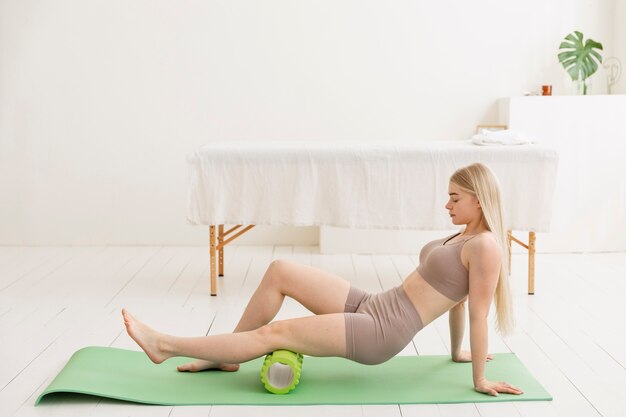
Most people experience tightness, soreness, stiffness, and that general feeling of being “crunchy.” Over time, these knots build up and our bodies compensate more severely, which can reduce our ability to function, the quality of our workouts, flexibility, and mobility, and can increase pain and soreness.
But, you can break this cycle with foam rolling!
Many people focus only on working out and forget about self-care. I’m here to tell you that regularly practicing stretching, foam rolling, and other self-care activities will not just improve your workouts but also your overall quality of life.
Everyday activities like working out, running errands, driving, or working at a desk engage our muscles. Often, we sit for long periods without moving, which can add unwanted tightness to our bodies. In short, we are constantly contracting and engaging various muscle groups all day long.
That’s why it’s important to bring our bodies back into balance and elongate the fascia again. Think of foam rolling as a self-massage. It helps eliminate painful knots and adhesions, making your body feel lighter and increasing functionality and mobility. This allows you to perform at your best more consistently.
Foam rolling works by applying pressure to tight areas to break up and dissipate knots. You can foam roll almost any part of your body – back, quads, glutes, hamstrings, triceps, chest, and more.
To foam roll, place the roller on the desired body part and roll through the muscle until you find a sore spot that rates about 6/7 on a pain scale from 1 to 10. Hold the foam roller on that spot for 30 seconds and repeat 2-3 times for each sore muscle. If you’re short on time, just focus on the tightest or sorest muscles. If a spot is extremely sore, you can hold for less than 30 seconds to avoid unbearable pain.
However, foam rolling should never cause actual pain or strain. If you experience sharp pain, stop immediately and consider contacting your doctor, especially based on your medical history. Foam rolling is meant to be slightly uncomfortable but should not produce searing pain.
You can foam roll almost anytime (except while driving). I recommend doing it when you wake up and before you go to bed and also before and after workouts. Adding just 10-15 minutes of foam rolling to your daily routine can make you feel better in a few weeks, and you’ll likely see better workout performance too.
For example, individuals new to foam rolling often find they can squat deeper after just five minutes of rolling their quads and hamstrings. Foam rolling is an incredible tool, but there are also other effective tools like tennis balls, lacrosse balls, or softballs, which can roll out tight areas like the feet, calves, glutes, and neck. Use the earlier mentioned 30-second hold technique with these objects too.
For areas like the neck, back, and glutes, try placing the ball on a wall and rolling while standing. Additionally, a Thera cane can be useful. It’s a plastic tool with knobs designed to release body tension. These are available online for around 20 bucks. The same hold principles apply.
Thera canes and small sports balls provide more targeted relief and can easily reach smaller body areas. Epsom salts can also help reduce muscle soreness. I recommend lavender Epsom salt bath bombs or rubs, and eucalyptus Epsom salts are very calming.
I’m also a big advocate for acupuncture and trigger point massages. While self-care at home is crucial, sometimes it’s beneficial to see a professional.
Thanks for taking the time to learn more about taking care of yourself and your muscles with foam rolling. Feel free to reach out to me via email with any comments or questions. Thanks for reading and stay tuned!